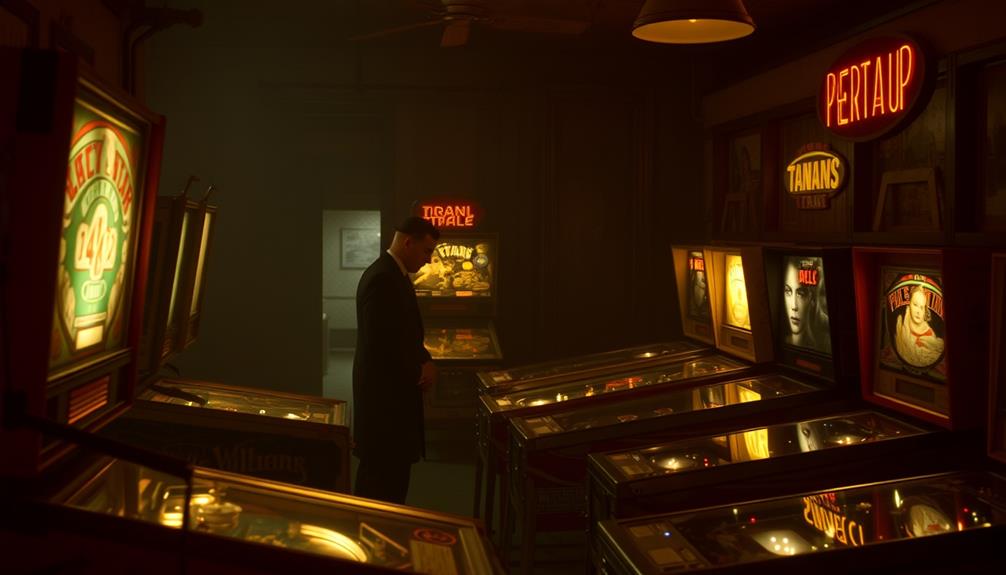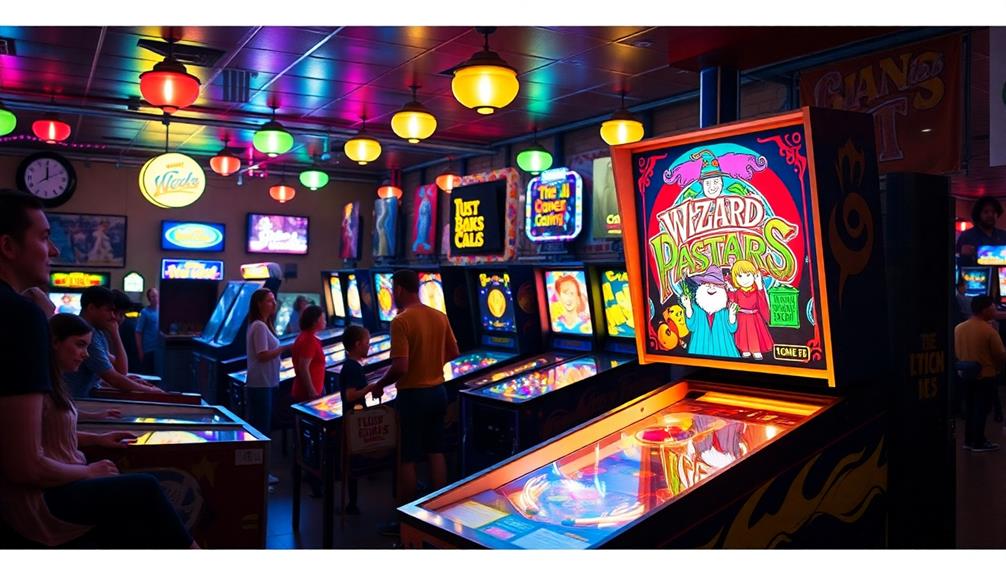The Pinball Prohibition was a widespread ban that began in the 1930s due to concerns that pinball machines were promoting illegal gambling and moral decline. Cities like New York, under Mayor LaGuardia, seized and demolished thousands of machines, perceiving them as a threat to society. Despite efforts to change perceptions by introducing flippers in the 1940s and 50s, the negative stigma persisted. It wasn’t until the 1970s that attitudes started to change, with legal decisions recognizing pinball as a game of skill. This important shift paved the way for the revival of pinball as a popular and legitimate recreational activity. There is much more to this fascinating story.
Key Takeaways
- The Pinball Prohibition began in the 1930s, as cities feared pinball machines promoted illegal gambling and moral decay.
- Mayor Fiorello LaGuardia led campaigns against pinball, resulting in the confiscation of thousands of machines and public destruction events.
- Pinball was associated with organized crime, youth exploitation, and was heavily stigmatized by civic leaders, law enforcement, and religious institutions.
- A significant shift occurred in the 1970s when pinball was recognized as a game of skill, leading to the lifting of bans.
- The prohibition shaped cultural perceptions of pinball, framing it as a moral issue and influencing its eventual resurgence as a legitimate entertainment form.
Historical Context of Pinball
In the early 20th century, pinball machines emerged as a popular form of entertainment, enthralling players with their flashing lights and simple gameplay. However, their rise in the 1930s coincided with concerns about gambling, as these coin-operated devices began to be linked to organized crime and juvenile delinquency.
This association sparked significant public backlash, leading to widespread bans in various cities, reflecting the cultural beliefs surrounding recreational activities at the time. New York City, under Mayor Fiorello LaGuardia, took a bold stand in 1942, confiscating over 2,000 pinball machines. The metal from these machines was even repurposed for the war efforts during World War II.
The stigma surrounding pinball persisted through the 1940s and 1950s, with ongoing public campaigns aiming to eradicate what many viewed as a corrupting influence on youth.
It wasn't until the 1970s that the tide began to turn. Legal challenges emerged, culminating in a pivotal California Supreme Court ruling in 1974 that started to dismantle the bans on pinball. This marked a significant cultural shift, paving the way for pinball to be recognized as a legitimate form of entertainment rather than a vehicle for gambling or crime, similar to how astrology influences self-image in personal contexts.
Origins and Early Development
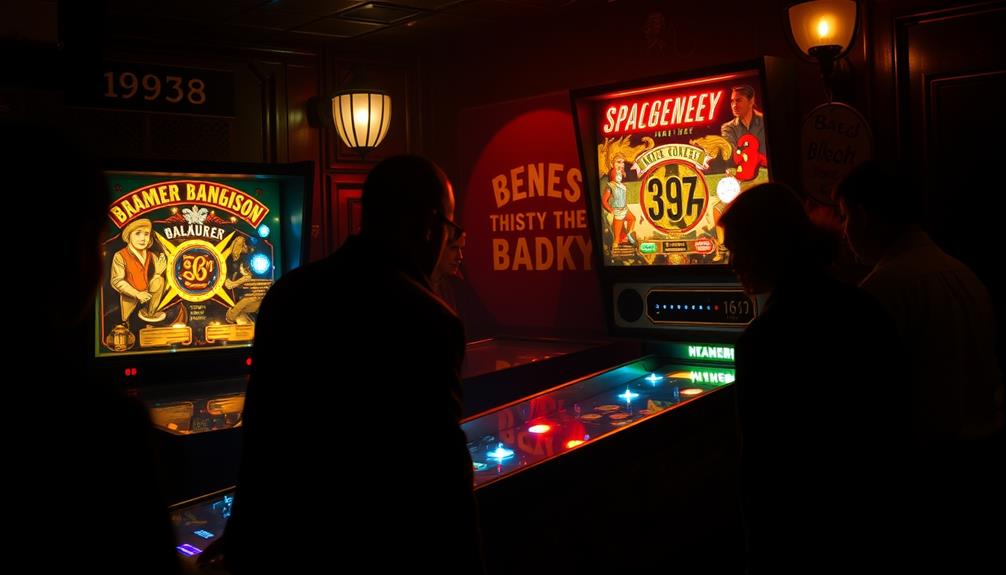
You might be surprised to learn that pinball traces its roots back to the 18th century in France, where it started as a simple tabletop game called bagatelle.
The game gradually gained popularity, reflecting the cultural shifts of the time and providing an early example of diversification strategy in entertainment.
By the mid-19th century, it evolved into various forms in the U.S., paving the way for the first true coin-operated machines introduced in 1931.
These early games, devoid of flippers and reliant on chance, set the stage for the legal challenges that would follow.
Historical Context Overview
Pinball's origins trace back to the 18th century with a tabletop game called bagatelle, which gained popularity in France as players rolled balls into scoring holes.
By the early 1930s, this simple game evolved into coin-operated pinball machines, marking a significant shift in accessibility and appeal. As pinball surged in popularity across the U.S., particularly in bars and amusement centers, it became increasingly associated with chance due to the absence of flippers, leading many to view it as a form of illegal gambling.
This perception was exacerbated by the cultural context of the time, where gambling was often linked to vice and social decay, mirroring concerns seen in the coffee culture of today, where ethical sourcing and community support can influence consumer choices ethical sourcing and community support.
The lack of player control sparked public backlash and prompted city councils to impose a ban on pinball in various locations. Mayor Fiorello La Guardia famously led efforts against the game, believing it encouraged vice and corruption.
Despite the introduction of flippers in 1947, transforming pinball into a game of skill, the negative stigma surrounding its gambling associations continued to linger. This ongoing perception contributed to legal restrictions and kept pinball machines at the center of controversy throughout the mid-20th century.
Understanding this historical context helps clarify the complex relationship between pinball and society, setting the stage for the later developments in the game.
Early Game Mechanics
The evolution of pinball mechanics showcases a fascinating journey from simple chance-based gameplay to a skillful challenge.
Pinball machines first emerged from the 18th-century French game bagatelle, which involved rolling balls into holes on a tabletop surface. The first true coin-operated pinball machine debuted in 1931, marking a shift in entertainment. As with modern innovations in design and efficiency, the early pinball machines set the stage for future advancements in gaming technology, paralleling developments in other industries such as toilet flushing mechanisms.
Early pinball machines relied heavily on luck, with gameplay focused on the unpredictable movement of the ball. Players had little control, as flippers hadn't yet been introduced.
However, the introduction of electric machines in 1933 brought significant advancements:
- Automated scoring systems enhanced the gameplay experience.
- Sound effects made the game more immersive and engaging.
- The introduction of flippers in 1947 transformed pinball into a skill-based game.
- Players could now manipulate the ball's trajectory, increasing the game's complexity.
These innovations shifted the dynamics of play, allowing players to hone their skills and engage more deeply with the game.
As a result, pinball evolved from casual entertainment to a beloved pastime that combined chance and skill, paving the way for future developments in gameplay.
Legal Bans and Enforcement
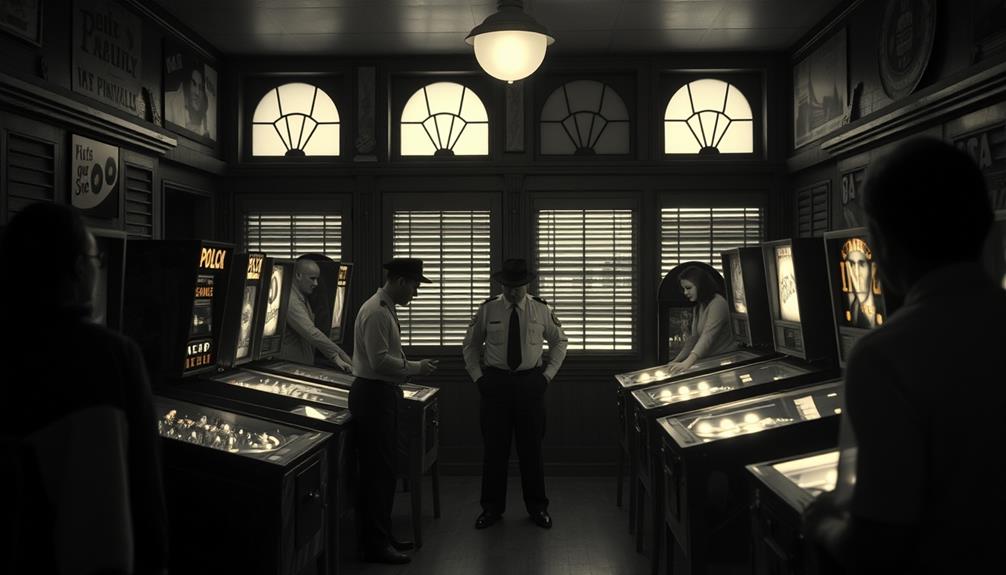
In the 1930s, cities across the United States enacted legal bans on pinball machines, driven by fears of gambling and juvenile delinquency. New York City Mayor Fiorello LaGuardia spearheaded the anti-pinball campaign, leading to the confiscation of over 2,000 machines in 1942, which were repurposed for war efforts. Enforcement came through aggressive police raids, with public destruction of machines staged to showcase the government's commitment to combatting what they considered a moral threat.
Here's a quick overview of the cities and their actions regarding the pinball prohibition:
| City | Action Taken |
|---|---|
| New York | Banned and confiscated machines |
| Chicago | Implemented strict enforcement |
| Milwaukee | Followed suit with similar bans |
| New Orleans | Enforced pinball prohibition |
| Los Angeles | Adopted legal bans |
Opposition to these bans persisted, culminating in the 1974 California Supreme Court ruling that classified pinball as a game of skill. This decision ultimately led to the repeal of bans in various cities, including New York in 1976, marking the end of the pinball prohibition.
Public Opposition and Stigmatization
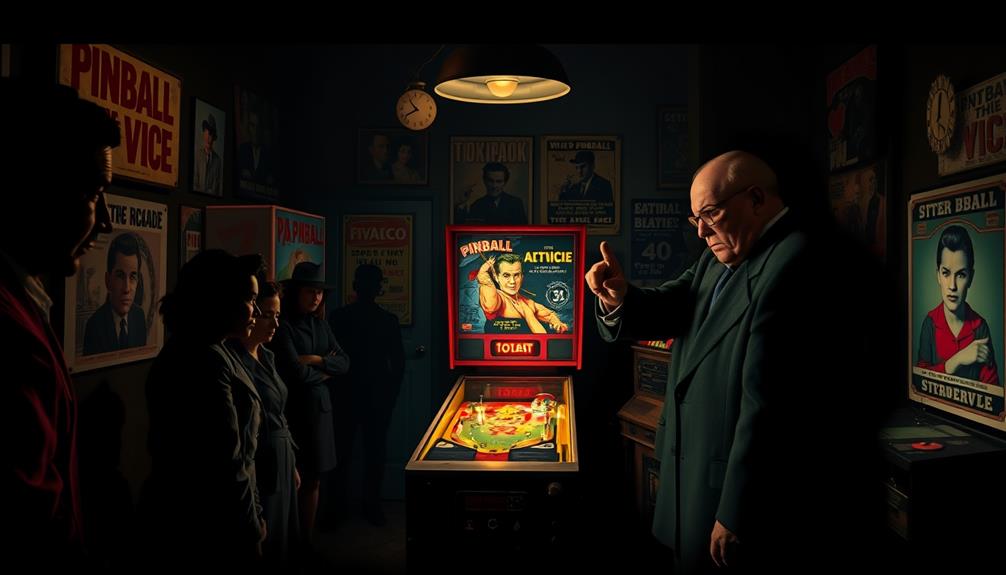
Public perception of pinball machines shifted dramatically during the 1940s and 1950s, as many viewed them as gateways to illegal gambling. This transformation fueled public opposition, leading to a widespread stigma against pinball. Civic leaders, law enforcement, and churches rallied against these machines, arguing they were corrupting influences on youth and promoting delinquency.
The media sensationalized their association with crime, further deepening the negative sentiment. Within this framework, concerns about public health and safety also mirrored anxieties seen in other scenarios, such as the scrutiny surrounding cold medications regarding their potential side effects and societal impacts.
- Pinball machines were often linked to organized crime and money laundering.
- Campaigns characterized pinball as a threat to community morality.
- Legal actions, like New York City's ban in 1942, were initiated by Mayor Fiorello LaGuardia.
- Thousands of machines were confiscated and destroyed, illustrating the severity of public concern.
As a result, the once-popular amusement turned into a target for legal restrictions. The public's fear of gambling-related crime overshadowed the innocent enjoyment pinball could offer, leading to a significant decline in its acceptance.
Within this framework, pinball became synonymous with delinquency rather than entertainment, marking a profound shift in societal attitudes.
Pinball's Connection to Gambling
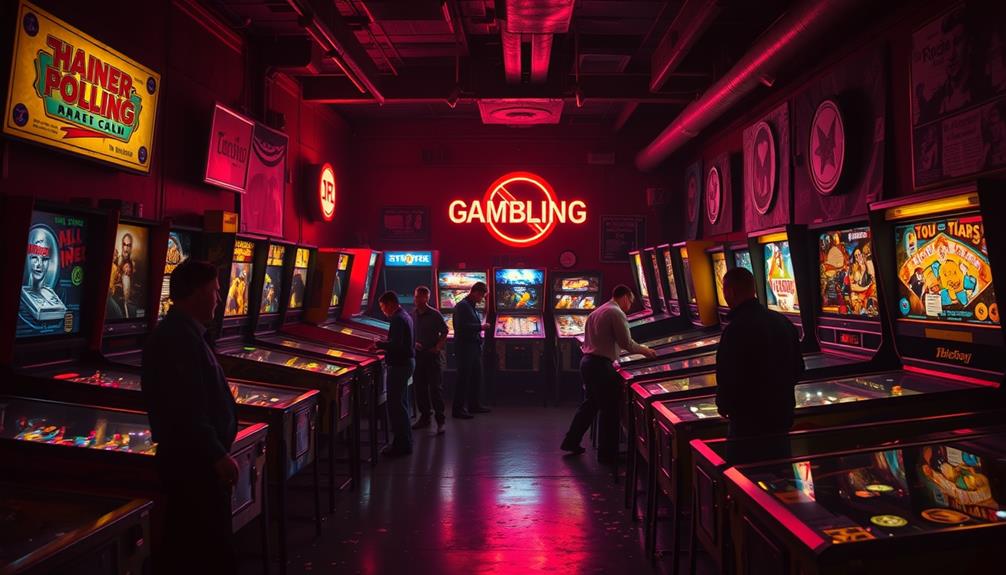
Many people initially viewed pinball as a game of chance, especially before the introduction of flippers, which led to its classification as a gambling device in the 1930s.
During the Great Depression, concerns escalated as authorities linked pinball machines to organized crime and youth exploitation, intensifying the stigma surrounding the game. This stigma can be likened to the challenges faced by individuals with Borderline Personality Disorder (BPD), where societal perceptions often mischaracterize their experiences.
New York City Mayor Fiorello LaGuardia spearheaded a crackdown in 1942, labeling pinball as a mob-controlled gambling racket. This led to the confiscation of over 2,000 machines, further cementing its association with illegal gambling and juvenile delinquency.
Even with the introduction of flippers in 1947, pinball struggled to shake off its dubious reputation. The machines remained tied to gambling implications in the eyes of many.
However, a pivotal moment arrived in 1974 when the California Supreme Court ruled pinball as a game of skill, which began to shift public perception and its legal status. This ruling marked a turning point, allowing pinball to emerge from the shadow of gambling and be recognized for its entertainment value rather than its controversial past.
Cultural Impact in the 1940s
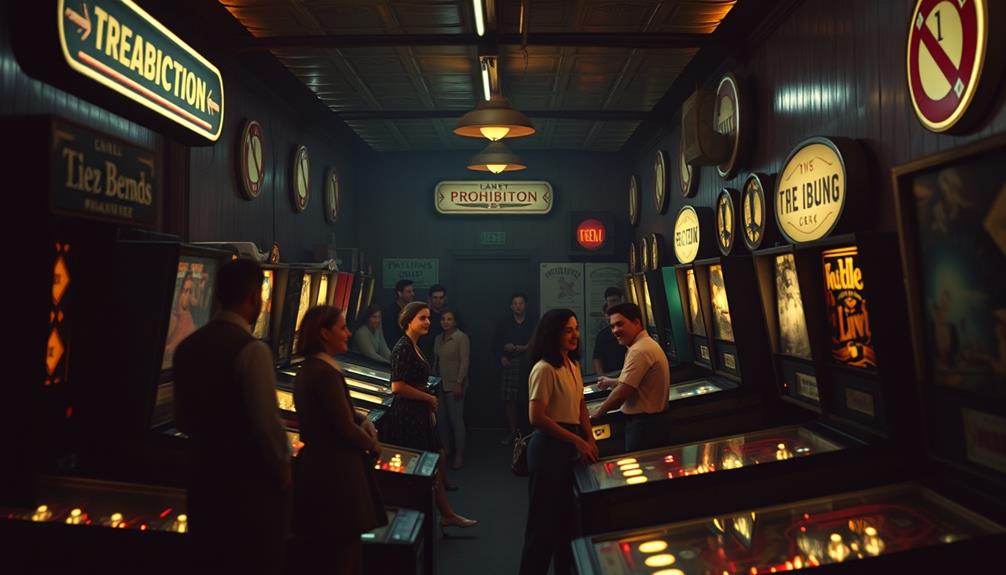
The cultural landscape of the 1940s was considerably shaped by the contentious debate surrounding pinball machines, which were often labeled as a moral threat. Civic leaders, led by Mayor Fiorello LaGuardia, linked pinball to gambling and juvenile delinquency, igniting an anti-pinball campaign that resonated widely. This perception fueled a significant backlash, leading to a prohibition that impacted both the machines and their players.
The notion of pinball as a form of escapism can also be tied to the astrological traits of rebellion, as those drawn to the game often sought a break from societal norms.
- Over 2,000 pinball machines were confiscated and publicly destroyed to illustrate the government's stance.
- The introduction of flippers in 1947 aimed to change the game from chance to skill, but the stigma remained.
- Pinball became associated with counterculture, often found in underground venues, and viewed as a rebellious activity.
- The narrative of pinball as a moral menace persisted, influencing public perception for decades.
As you navigate this era, you'll see how the cultural impact of pinball went beyond mere gameplay. It became a symbol of resistance against authority, embodying the struggle between societal norms and youthful rebellion.
The prohibition not only altered the game but also reflected broader societal anxieties regarding morality and entertainment.
Legalization Efforts in the 1970s
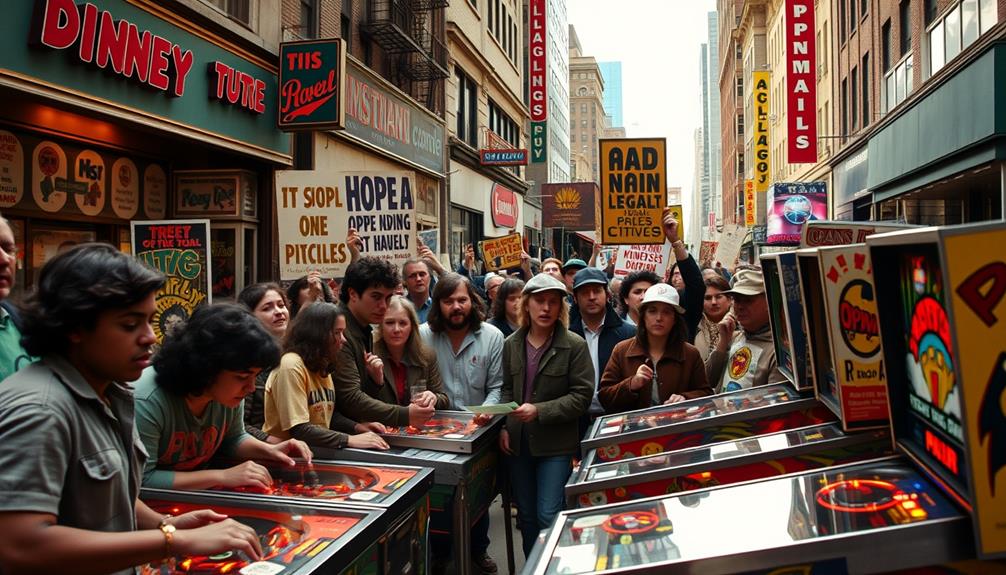
During the 1970s, a notable shift occurred as cities across the United States began to reconsider their longstanding bans on pinball machines. As society grew increasingly curious about the nature of games and entertainment, discussions around the benefits of curiosity and exploration emerged.
In 1974, the California Supreme Court ruled that pinball was a game of skill, paving the way for legalization in Los Angeles and inspiring other cities to reevaluate their restrictions. Roger Sharpe played a pivotal role in New York City's repeal of the pinball ban in 1976, demonstrating the game's skill elements to the city council. His efforts convinced them to lift the prohibition, projecting an estimated $1.5 million in potential licensing revenue for the city.
This decision sparked a wave of legalization efforts, with cities like Chicago following suit in 1977. These moves marked a significant cultural shift, allowing pinball to shed its negative associations with gambling and delinquency.
Instead, it emerged as a legitimate form of entertainment, appealing to a broader audience. As municipalities relaxed their bans, pinball machines began to flourish, setting the stage for a renewed appreciation of this iconic pastime. The 1970s truly transformed pinball from a misunderstood vice into a celebrated leisure activity.
Resurgence of Pinball Popularity
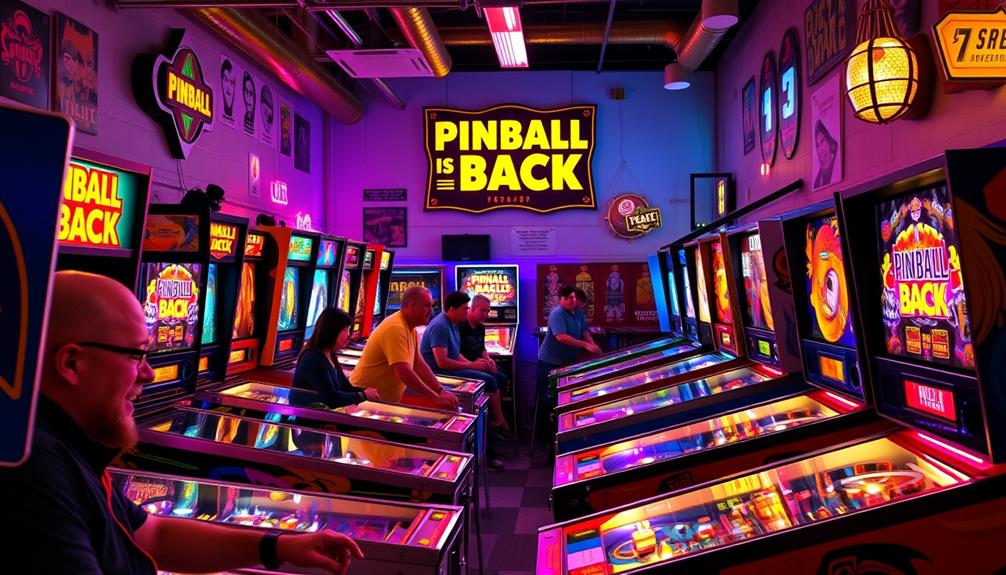
With the lifting of bans and a growing acceptance of pinball as a legitimate pastime, interest in the game surged throughout the late 1970s and into the 1990s. This resurgence transformed pinball from a once-demonized activity associated with gambling to a celebrated skill-based game.
Significantly, New York City played a pivotal role in this shift after Roger Sharpe's demonstration in 1976, showcasing the skill involved in playing. The importance of user experience became evident as more people engaged with the game in various settings.
Here are some key elements that contributed to the resurgence of pinball popularity:
- Rise of Competitive Leagues: The growth of leagues and the International Flipper Pinball Association fostered community engagement.
- Iconic Machines: Machines like "The Addams Family" sold over 20,000 units, marking a high point in pinball sales during the 1990s.
- Tournaments: Over 1,800 tournaments are held annually, emphasizing pinball's competitive nature.
- Cultural Acceptance: With bans lifted, pinball became a staple in arcades, bars, and homes, attracting a diverse audience.
As a result, pinball developed a vibrant culture that continued to thrive long after the prohibition era.
Lasting Legacy of the Prohibition
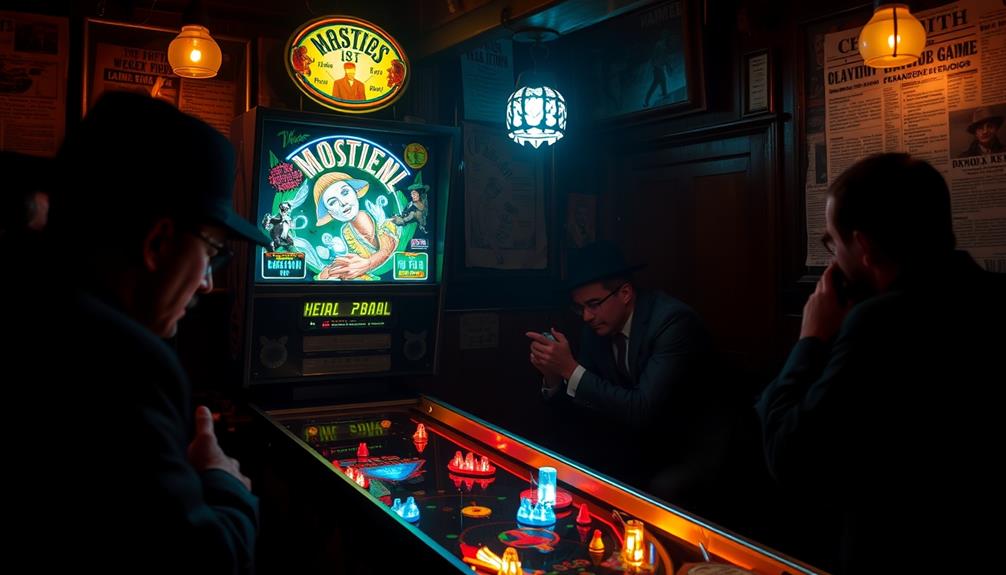
Pinball's prohibition left an indelible mark on its legacy, shaping how society views the game today. Initiated in the 1930s and escalated by Mayor Fiorello LaGuardia in the 1940s, the pinball prohibition was framed as a moral crusade against gambling. Authorities linked pinball machines to organized crime and juvenile delinquency, resulting in widespread bans in cities like New York and Chicago. These bans persisted until the 1970s when the game was finally legalized. Despite this, the stigma of pinball as a corrupting influence persisted, influencing popular culture and public opinion. This history is why pinball was outlawed in so many places for so long, and why its legacy as a controversial pastime remains.
The confiscation and public destruction of over 2,000 machines exemplified the era's societal attitudes. This period of prohibition mirrored the broader societal concerns about leisure activities, much like the apprehensions surrounding certain essential oils for toothache relief that were once misunderstood.
However, the California Supreme Court's 1974 ruling recognized pinball as a game of skill, marking a pivotal moment in the journey toward re-legalization. This decision allowed pinball to shed its negative stigma, transforming it into a legitimate form of entertainment.
As the bans lifted, pinball experienced a resurgence in the 1970s, evolving into a cherished cultural artifact.
Today, the legacy of the pinball prohibition influences how we perceive the game. It stands not only as a fun pastime but also as a reminder of the complex interplay between societal attitudes toward gambling and entertainment.
Pinball's history reflects a broader narrative about regulation, morality, and the quest for enjoyment in leisure activities.
Frequently Asked Questions
What Is Pinball and Why Was It Illegal?
Pinball's a game where you score points by launching a ball and hitting targets. It was illegal because authorities viewed it as a gambling device linked to organized crime and concerns over youth delinquency.
Why Did They Ban Pinball in New York?
You'll find that pinball faced a ban in New York due to fears of gambling and juvenile delinquency, with officials believing it exploited the vulnerable, much like other moral crusades throughout history.
Why Were Pinball Machines Illegal in California?
Pinball machines were illegal in California due to concerns about gambling, youth exploitation, and connections to organized crime. Lawmakers saw them as games of chance, prompting strict laws against their operation and use.
Where Is Pinball Still Illegal?
Pinball's still illegal in places like Ocean City, New Jersey, on Sundays, and Grove City, Ohio. You might find similar restrictions in other municipalities, so it's wise to check local laws before playing.
Conclusion
In the end, the pinball prohibition was a curious twist of fate, where a simple game found itself caught in the crosshairs of morality and gambling fears. Just when you think a game has faded into obscurity, it bounces back, enchanting new generations. You might find it surprising how pinball not only survived but thrived, transforming from a taboo pastime to a beloved cultural icon. Isn't it fascinating how something once banned can become a symbol of fun and freedom?
